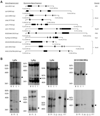Polymorphisms in Ly6 genes in Msq1 encoding susceptibility to mouse adenovirus type 1
- PMID: 22101863
- PMCID: PMC3299859
- DOI: 10.1007/s00335-011-9368-9
Polymorphisms in Ly6 genes in Msq1 encoding susceptibility to mouse adenovirus type 1
Abstract
Strain-specific differences in susceptibility to mouse adenovirus type 1 (MAV-1) are linked to the quantitative trait locus Msq1 on mouse chromosome 15. This region contains 14 Ly6 or Ly6-related genes, many of which are known to be expressed on the surface of immune cells, suggesting a possible role in host defense. We analyzed these genes for polymorphisms between MAV-1-susceptible and MAV-1-resistant inbred mouse strains. Sequencing of cDNAs identified 12 coding-region polymorphisms in 2010109I03Rik, Ly6e, Ly6a, Ly6c1, and Ly6c2, six of which were nonsynonymous and five of which were previously unlisted in dbSNP Build 132. We also clarified sequence discrepancies in GenBank for the coding regions of I830127L07Rik and Ly6g. Additionally, Southern blotting revealed size polymorphisms within the DNA regions of Ly6e, Ly6a, and Ly6g. Collectively, these genetic variations have implications for the structure, function, and/or expression of Ly6 and Ly6-related genes that may contribute to the observed strain-specific differences in susceptibility to MAV-1.
Figures



Similar articles
-
Contribution of a single host genetic locus to mouse adenovirus type 1 infection and encephalitis.mBio. 2012 May 29;3(3):e00131-12. doi: 10.1128/mBio.00131-12. Print 2012. mBio. 2012. PMID: 22647790 Free PMC article.
-
The major locus for mouse adenovirus susceptibility maps to genes of the hematopoietic cell surface-expressed LY6 family.J Immunol. 2010 Mar 15;184(6):3055-62. doi: 10.4049/jimmunol.0903363. Epub 2010 Feb 17. J Immunol. 2010. PMID: 20164425 Free PMC article.
-
Identification of quantitative trait loci for susceptibility to mouse adenovirus type 1.J Virol. 2005 Sep;79(17):11517-22. doi: 10.1128/JVI.79.17.11517-11522.2005. J Virol. 2005. PMID: 16103204 Free PMC article.
-
Ly6 family proteins in neutrophil biology.J Leukoc Biol. 2013 Oct;94(4):585-94. doi: 10.1189/jlb.0113014. Epub 2013 Mar 29. J Leukoc Biol. 2013. PMID: 23543767 Review.
-
Organization, evolution and functions of the human and mouse Ly6/uPAR family genes.Hum Genomics. 2016 Apr 21;10:10. doi: 10.1186/s40246-016-0074-2. Hum Genomics. 2016. PMID: 27098205 Free PMC article. Review.
Cited by
-
Computational Analysis of the Global Effects of Ly6E in the Immune Response to Coronavirus Infection Using Gene Networks.Genes (Basel). 2020 Jul 21;11(7):831. doi: 10.3390/genes11070831. Genes (Basel). 2020. PMID: 32708319 Free PMC article.
-
The GPI-Linked Protein LY6A Drives AAV-PHP.B Transport across the Blood-Brain Barrier.Mol Ther. 2019 May 8;27(5):912-921. doi: 10.1016/j.ymthe.2019.02.013. Epub 2019 Feb 20. Mol Ther. 2019. PMID: 30819613 Free PMC article.
-
CD4-Dependent Modulation of HIV-1 Entry by LY6E.J Virol. 2019 Mar 21;93(7):e01866-18. doi: 10.1128/JVI.01866-18. Print 2019 Apr 1. J Virol. 2019. PMID: 30674630 Free PMC article.
-
Interferon-inducible LY6E Protein Promotes HIV-1 Infection.J Biol Chem. 2017 Mar 17;292(11):4674-4685. doi: 10.1074/jbc.M116.755819. Epub 2017 Jan 27. J Biol Chem. 2017. PMID: 28130445 Free PMC article.
-
The genetic basis for individual differences in mRNA splicing and APOBEC1 editing activity in murine macrophages.Genome Res. 2014 Mar;24(3):377-89. doi: 10.1101/gr.166033.113. Epub 2013 Nov 18. Genome Res. 2014. PMID: 24249727 Free PMC article.
References
-
- Bamezai A. Mouse Ly-6 proteins and their extended family: Markers of cell differentiation and regulators of cell signaling. Arch Immunol Ther Exp (Warsz) 2004;52:255–266. - PubMed
-
- Behrendt N, Ploug M, Patthy L, Houen G, Blasi F, Dano K. The ligand-binding domain of the cell surface receptor for urokinase-type plasminogen activator. J Biol Chem. 1991;266:7842–7847. - PubMed
-
- Bothwell A, Pace PE, LeClair KP. Isolation and expression of an IFN-responsive Ly-6C chromosomal gene. J Immunol. 1988;140:2815–2820. - PubMed
-
- Brass AL, Dykxhoorn DM, Benita Y, Yan N, Engelman A, Xavier RJ, Lieberman J, Elledge SJ. Identification of host proteins required for HIV infection through a functional genomic screen. Science. 2008;319:921–926. - PubMed
-
- Charles PC, Chen X, Horwitz MS, Brosnan CF. Differential chemokine induction by the mouse adenovirus type-1 in the central nervous system of susceptible and resistant strains of mice. J Neurovirol. 1999;5:55–64. - PubMed
Publication types
MeSH terms
Substances
Grants and funding
LinkOut - more resources
Full Text Sources
Molecular Biology Databases
Research Materials

